- Make sure that the last successfully loaded config is used on hot-reload failure - Properly cleanup resources occupied by already initialized aggregators when the current aggregator fails to be initialized - Expose distinct vmagent_streamaggr_config_reload* metrics per each -remoteWrite.streamAggr.config This should simplify monitoring and debugging failed reloads - Remove race condition at app/vminsert/common.MustStopStreamAggr when calling sa.MustStop() while sa could be in use at realoadSaConfig() - Remove lib/streamaggr.aggregator.hasState global variable, since it may negatively impact scalability on system with big number of CPU cores at hasState.Store(true) call inside aggregator.Push(). - Remove fine-grained aggregator reload - reload all the aggregators on config change instead. This simplifies the code a bit. The fine-grained aggregator reload may be returned back if there will be demand from real users for it. - Check -relabelConfig and -streamAggr.config files when single-node VictoriaMetrics runs with -dryRun flag - Return back accidentally removed changelog for v1.87.4 at docs/CHANGELOG.md Updates https://github.com/VictoriaMetrics/VictoriaMetrics/issues/3639
26 KiB
| sort |
|---|
| 98 |
streaming aggregation
vmagent and single-node VictoriaMetrics can aggregate incoming samples in streaming mode by time and by labels. The aggregation is applied to all the metrics received via any supported data ingestion protocol and/or scraped from Prometheus-compatible targets.
The stream aggregation is configured via the following command-line flags:
-remoteWrite.streamAggr.configat vmagent. This flag can be specified individually per each-remoteWrite.url. This allows writing different aggregates to different remote storage destinations.-streamAggr.configat single-node VictoriaMetrics.
These flags must point to a file containing stream aggregation config.
By default only the aggregated data is written to the storage. If the original incoming samples must be written to the storage too, then the following command-line flags must be specified:
-remoteWrite.streamAggr.keepInputat vmagent. This flag can be specified individually per each-remoteWrite.url. This allows writing both raw and aggregate data to different remote storage destinations.-streamAggr.keepInputat single-node VictoriaMetrics.
Stream aggregation ignores timestamps associated with the input samples. It expects that the ingested samples have timestamps close to the current time.
By default all the input samples are aggregated. Sometimes it is needed to de-duplicate samples before the aggregation. For example, if the samples are received from replicated sources. The following command-line flag can be used for enabling the de-duplication before aggregation in this case:
-remoteWrite.streamAggr.dedupIntervalat vmagent. This flag can be specified individually per each-remoteWrite.url. This allows setting different de-duplication intervals per each configured remote storage.-streamAggr.dedupIntervalat single-node VictoriaMetrics.
Use cases
Stream aggregation can be used in the following cases:
- Statsd alternative
- Recording rules alternative
- Reducing the number of stored samples
- Reducing the number of stored series
Statsd alternative
Stream aggregation can be used as statsd alternative in the following cases:
- Counting input samples
- Summing input metrics
- Quantiles over input metrics
- Histograms over input metrics
Recording rules alternative
Sometimes alerting queries may require non-trivial amounts of CPU, RAM,
disk IO and network bandwidth at metrics storage side. For example, if http_request_duration_seconds histogram is generated by thousands
of application instances, then the alerting query histogram_quantile(0.99, sum(increase(http_request_duration_seconds_bucket[5m])) without (instance)) > 0.5
can become slow, since it needs to scan too big number of unique time series
with http_request_duration_seconds_bucket name. This alerting query can be sped up by pre-calculating
the sum(increase(http_request_duration_seconds_bucket[5m])) without (instance) via recording rule.
But this recording rule may take too much time to execute too. In this case the slow recording rule can be substituted
with the following stream aggregation config:
- match: 'http_request_duration_seconds_bucket'
interval: 5m
without: [instance]
outputs: [total]
This stream aggregation generates http_request_duration_seconds_bucket:5m_without_instance_total output series according to output metric naming.
Then these series can be used in alerting rules:
histogram_quantile(0.99, last_over_time(http_request_duration_seconds_bucket:5m_without_instance_total[5m])) > 0.5
This query is executed much faster than the original query, because it needs to scan much lower number of time series.
See the list of aggregate output, which can be specified at output field.
See also aggregating by labels.
Field interval is recommended to be set to a value at least several times higher than your metrics collect interval.
Reducing the number of stored samples
If per-series samples are ingested at high frequency, then this may result in high disk space usage, since too much data must be stored to disk. This also may result in slow queries, since too much data must be processed during queries.
This can be fixed with the stream aggregation by increasing the interval between per-series samples stored in the database.
For example, the following stream aggregation config reduces the frequency of input samples to one sample per 5 minutes per each input time series (this operation is also known as downsampling):
# Aggregate metrics ending with _total with `total` output.
# See https://docs.victoriametrics.com/stream-aggregation.html#aggregation-outputs
- match: '{__name__=~".+_total"}'
interval: 5m
outputs: [total]
# Downsample other metrics with `count_samples`, `sum_samples`, `min` and `max` outputs
# See https://docs.victoriametrics.com/stream-aggregation.html#aggregation-outputs
- match: '{__name__!~".+_total"}'
interval: 5m
outputs: [count_samples, sum_samples, min, max]
The aggregated output metrics have the following names according to output metric naming:
# For input metrics ending with _total
some_metric_total:5m_total
# For input metrics not ending with _total
some_metric:5m_count_samples
some_metric:5m_sum_samples
some_metric:5m_min
some_metric:5m_max
See the list of aggregate output, which can be specified at output field.
See also aggregating by labels.
Reducing the number of stored series
Sometimes applications may generate too many time series.
For example, the http_requests_total metric may have path or user label with too big number of unique values.
In this case the following stream aggregation can be used for reducing the number metrics stored in VictoriaMetrics:
- match: 'http_requests_total'
interval: 30s
without: [path, user]
outputs: [total]
This config specifies labels, which must be removed from the aggregate output, in the without list.
See these docs for more details.
The aggregated output metric has the following name according to output metric naming:
http_requests_total:30s_without_path_user_total
See the list of aggregate output, which can be specified at output field.
Counting input samples
If the monitored application generates event-based metrics, then it may be useful to count the number of such metrics at stream aggregation level.
For example, if an advertising server generates hits{some="labels"} 1 and clicks{some="labels"} 1 metrics
per each incoming hit and click, then the following stream aggregation config
can be used for counting these metrics per every 30 second interval:
- match: '{__name__=~"hits|clicks"}'
interval: 30s
outputs: [count_samples]
This config generates the following output metrics for hits and clicks input metrics
according to output metric naming:
hits:30s_count_samples count1
clicks:30s_count_samples count2
See the list of aggregate output, which can be specified at output field.
See also aggregating by labels.
Summing input metrics
If the monitored application calculates some events and then sends the calculated number of events to VictoriaMetrics at irregular intervals or at too high frequency, then stream aggregation can be used for summing such events and writing the aggregate sums to the storage at regular intervals.
For example, if an advertising server generates hits{some="labels} N and clicks{some="labels"} M metrics
at irregular intervals, then the following stream aggregation config
can be used for summing these metrics per every minute:
- match: '{__name__=~"hits|clicks"}'
interval: 1m
outputs: [sum_samples]
This config generates the following output metrics according to output metric naming:
hits:1m_sum_samples sum1
clicks:1m_sum_samples sum2
See the list of aggregate output, which can be specified at output field.
See also aggregating by labels.
Quantiles over input metrics
If the monitored application generates measurement metrics per each request, then it may be useful to calculate the pre-defined set of percentiles over these measurements.
For example, if the monitored application generates request_duration_seconds N and response_size_bytes M metrics
per each incoming request, then the following stream aggregation config
can be used for calculating 50th and 99th percentiles for these metrics every 30 seconds:
- match: '{__name__=~"request_duration_seconds|response_size_bytes"}'
interval: 30s
outputs: ["quantiles(0.50, 0.99)"]
This config generates the following output metrics according to output metric naming:
request_duration_seconds:30s_quantiles{quantile="0.50"} value1
request_duration_seconds:30s_quantiles{quantile="0.99"} value2
response_size_bytes:30s_quantiles{quantile="0.50"} value1
response_size_bytes:30s_quantiles{quantile="0.99"} value2
See the list of aggregate output, which can be specified at output field.
See also histograms over input metrics and aggregating by labels.
Histograms over input metrics
If the monitored application generates measurement metrics per each request, then it may be useful to calculate a histogram over these metrics.
For example, if the monitored application generates request_duration_seconds N and response_size_bytes M metrics
per each incoming request, then the following stream aggregation config
can be used for calculating VictoriaMetrics histogram buckets
for these metrics every 60 seconds:
- match: '{__name__=~"request_duration_seconds|response_size_bytes"}'
interval: 60s
outputs: [histogram_bucket]
This config generates the following output metrics according to output metric naming.
request_duration_seconds:60s_histogram_bucket{vmrange="start1...end1"} count1
request_duration_seconds:60s_histogram_bucket{vmrange="start2...end2"} count2
...
request_duration_seconds:60s_histogram_bucket{vmrange="startN...endN"} countN
response_size_bytes:60s_histogram_bucket{vmrange="start1...end1"} count1
response_size_bytes:60s_histogram_bucket{vmrange="start2...end2"} count2
...
response_size_bytes:60s_histogram_bucket{vmrange="startN...endN"} countN
The resulting histogram buckets can be queried with MetricsQL in the following ways:
-
An estimated 50th and 99th percentiles of the request duration over the last hour:
histogram_quantiles("quantile", 0.50, 0.99, sum(increase(request_duration_seconds:60s_histogram_bucket[1h])) by (vmrange))This query uses histogram_quantiles function.
-
An estimated standard deviation of the request duration over the last hour:
histogram_stddev(sum(increase(request_duration_seconds:60s_histogram_bucket[1h])) by (vmrange))This query uses histogram_stddev function.
-
An estimated share of requests with the duration smaller than
0.5sover the last hour:histogram_share(0.5, sum(increase(request_duration_seconds:60s_histogram_bucket[1h])) by (vmrange))This query uses histogram_share function.
See the list of aggregate output, which can be specified at output field.
See also quantiles over input metrics and aggregating by labels.
Output metric names
Output metric names for stream aggregation are constructed according to the following pattern:
<metric_name>:<interval>[_by_<by_labels>][_without_<without_labels>]_<output>
<metric_name>is the original metric name.<interval>is the interval specified in the stream aggregation config.<by_labels>is_-delimited sorted list ofbylabels specified in the stream aggregation config. If thebylist is missing in the config, then the_by_<by_labels>part isn't included in the output metric name.<without_labels>is an optional_-delimited sorted list ofwithoutlabels specified in the stream aggregation config. If thewithoutlist is missing in the config, then the_without_<without_labels>part isn't included in the output metric name.<output>is the aggregate used for constucting the output metric. The aggregate name is taken from theoutputslist at the corresponding stream aggregation config.
Both input and output metric names can be modified if needed via relabeling according to these docs.
Relabeling
It is possible to apply arbitrary relabeling to input and output metrics
during stream aggregation via input_relabel_configs and output_relabel_config options in stream aggregation config.
For example, the following config removes the :1m_sum_samples suffix added to the output metric name:
- interval: 1m
outputs: [sum_samples]
output_relabel_configs:
- source_labels: [__name__]
target_label: __name__
regex: "(.+):.+"
Aggregation outputs
The aggregations are calculated during the interval specified in the config
and then sent to the storage.
If by and without lists are specified in the config,
then the aggregation by labels is performed additionally to aggregation by interval.
Below are aggregation functions that can be put in the outputs list at stream aggregation config.
total
total generates output counter by summing the input counters.
total only makes sense for aggregating counter type metrics.
The results of total is equal to the sum(some_counter) query.
For example, see below time series produced by config with aggregation interval 1m and by: ["instance"] and the regular query:
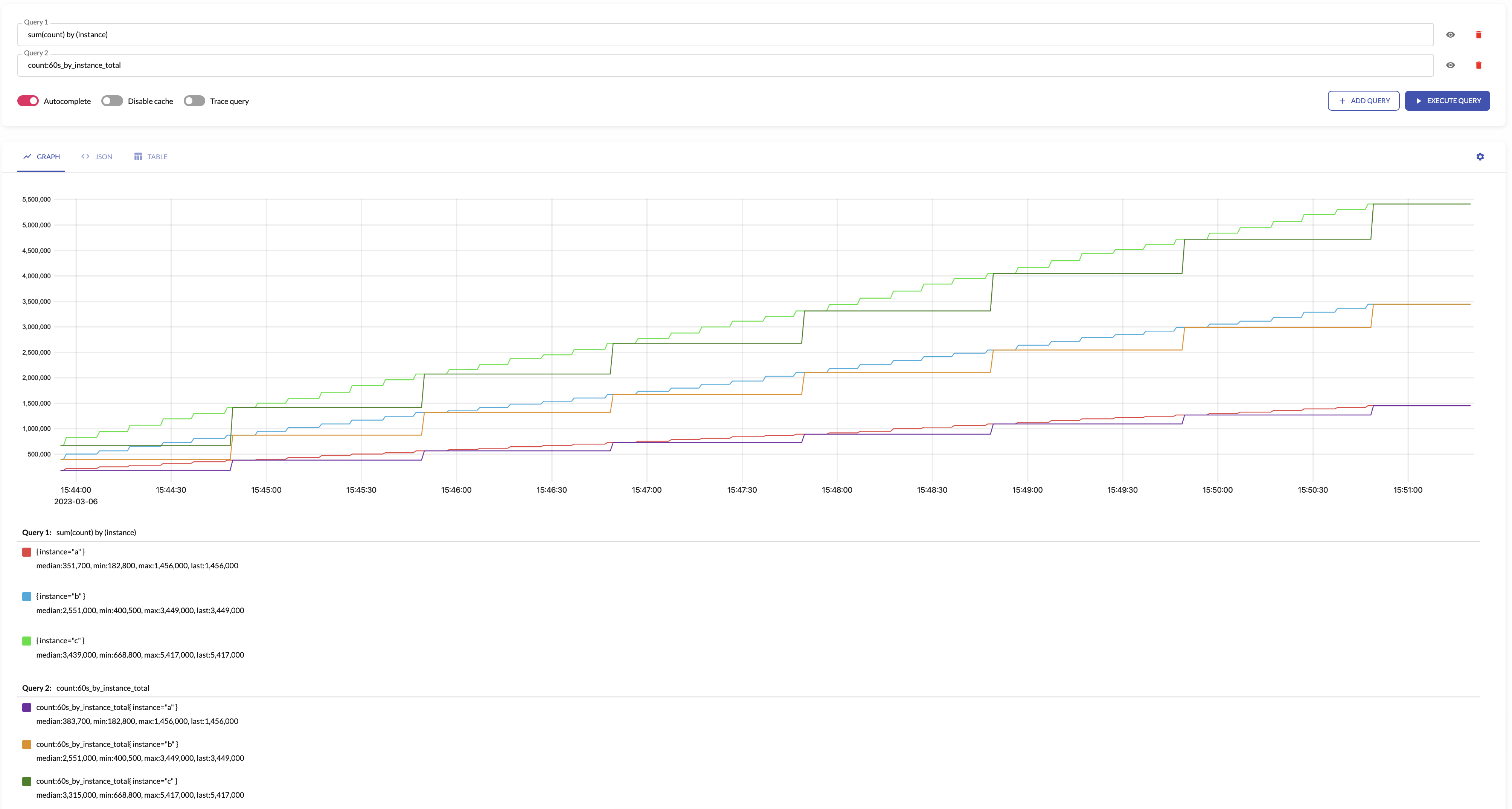
increase
increase returns the increase of input counters.
increase only makes sense for aggregating counter type metrics.
The results of increase with aggregation interval of 1m is equal to the increase(some_counter[1m]) query.
For example, see below time series produced by config with aggregation interval 1m and by: ["instance"] and the regular query:
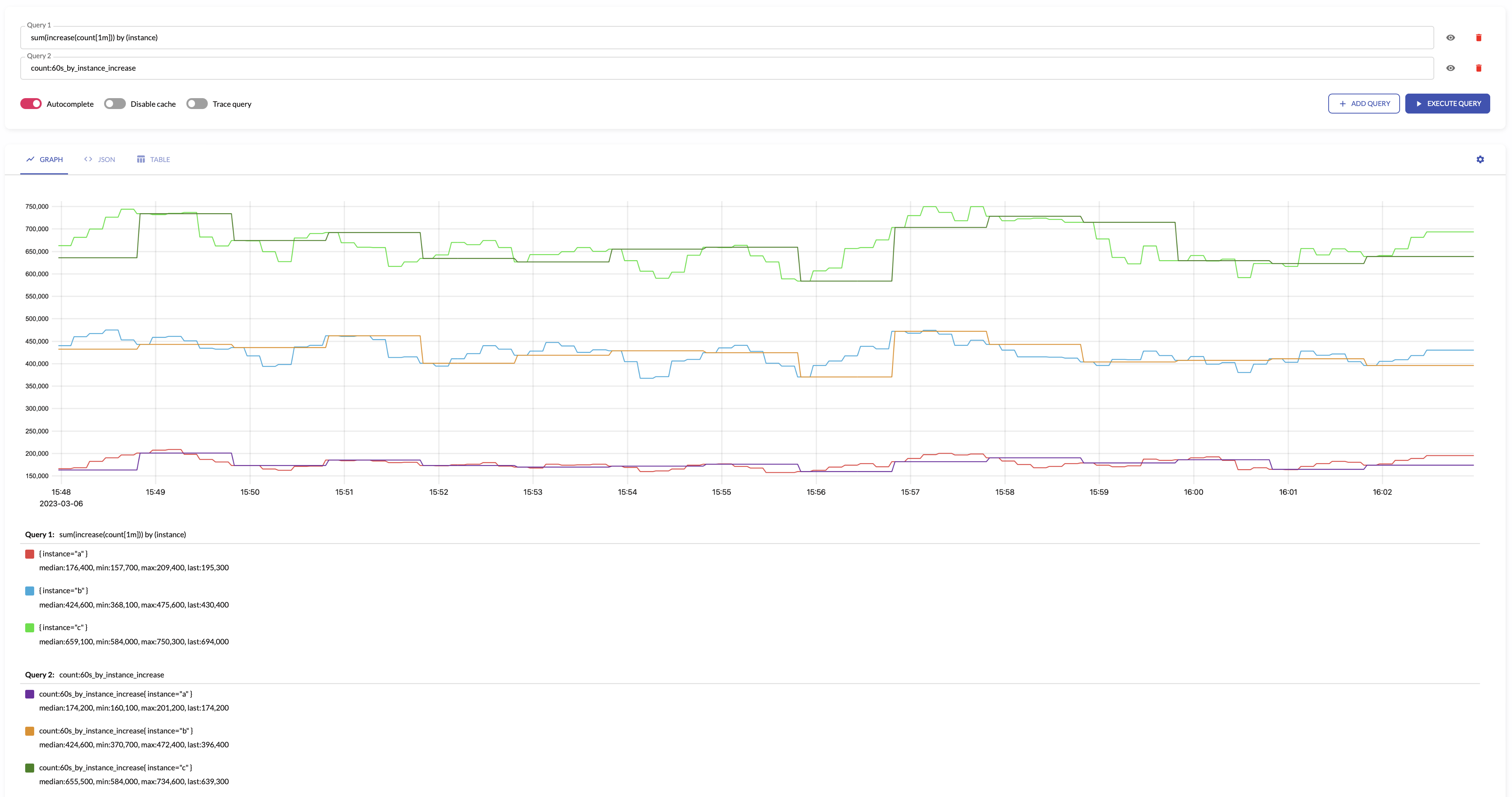
count_series
count_series counts the number of unique time series.
The results of count_series is equal to the count(some_metric) query.
count_samples
count_samples counts the number of input samples.
The results of count_samples with aggregation interval of 1m is equal to the count_over_time(some_metric[1m]) query.
sum_samples
sum_samples sums input sample values.
The results of sum_samples with aggregation interval of 1m is equal to the sum_over_time(some_metric[1m]) query.
For example, see below time series produced by config with aggregation interval 1m and the regular query:
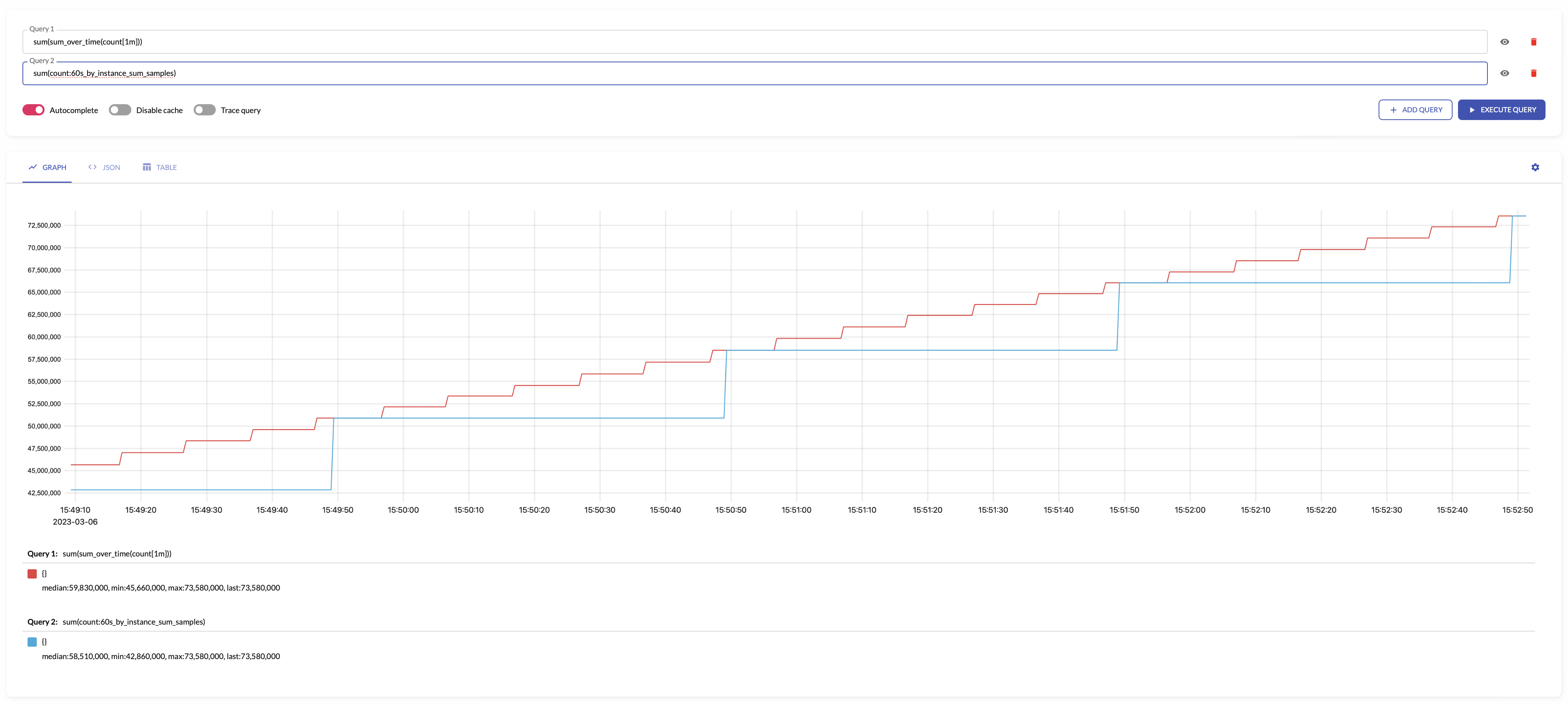
last
last returns the last input sample value.
The results of last with aggregation interval of 1m is equal to the last_over_time(some_metric[1m]) query.
This aggregation output doesn't make much sense with by lists specified in the config.
The result of aggregation by labels in this case will be undetermined, because it depends on the order of processing the time series.
min
min returns the minimum input sample value.
The results of min with aggregation interval of 1m is equal to the min_over_time(some_metric[1m]) query.
For example, see below time series produced by config with aggregation interval 1m and the regular query:
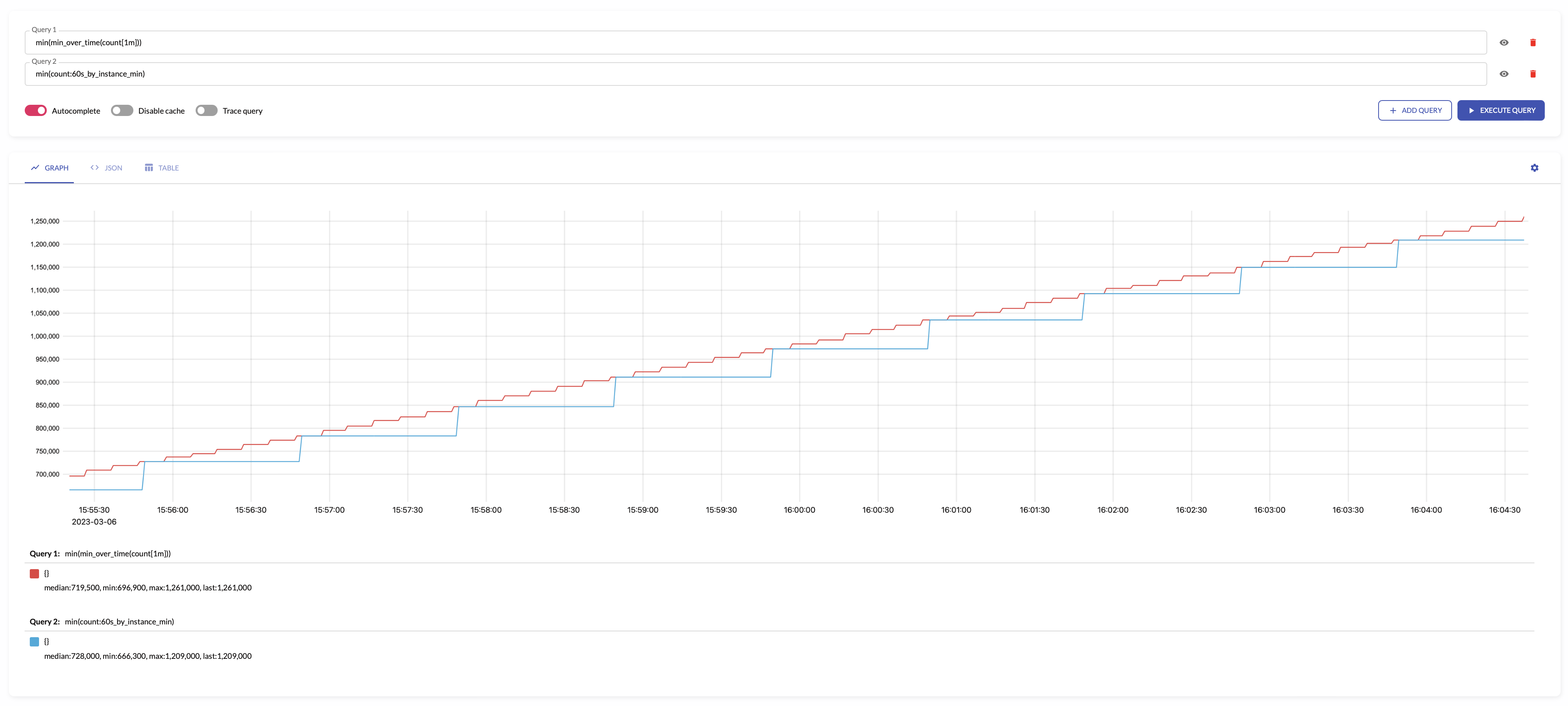
max
max returns the maximum input sample value.
The results of max with aggregation interval of 1m is equal to the max_over_time(some_metric[1m]) query.
For example, see below time series produced by config with aggregation interval 1m and the regular query:
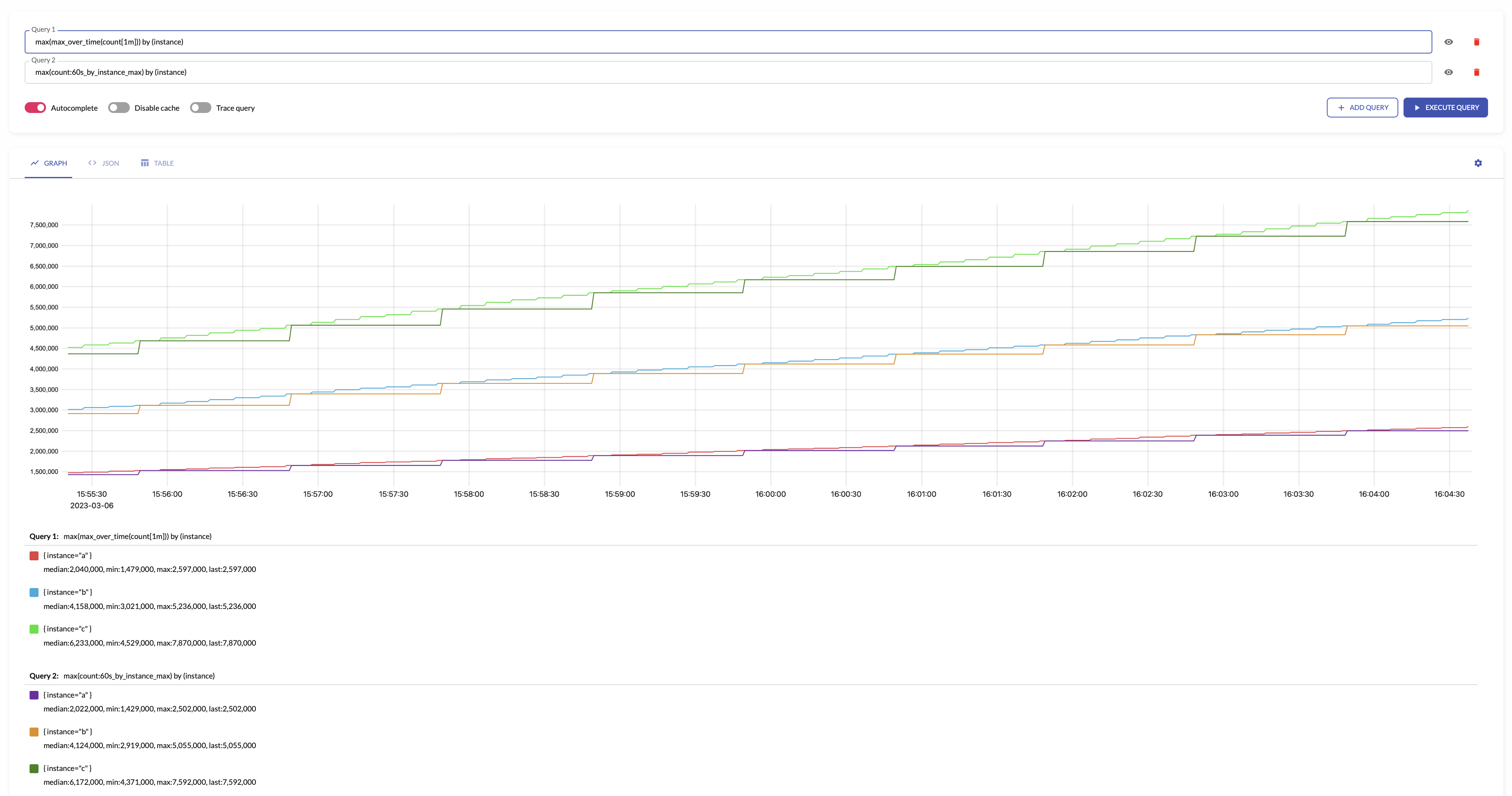
avg
avg returns the average input sample value.
The results of avg with aggregation interval of 1m is equal to the avg_over_time(some_metric[1m]) query.
For example, see below time series produced by config with aggregation interval 1m and by: ["instance"] and the regular query:
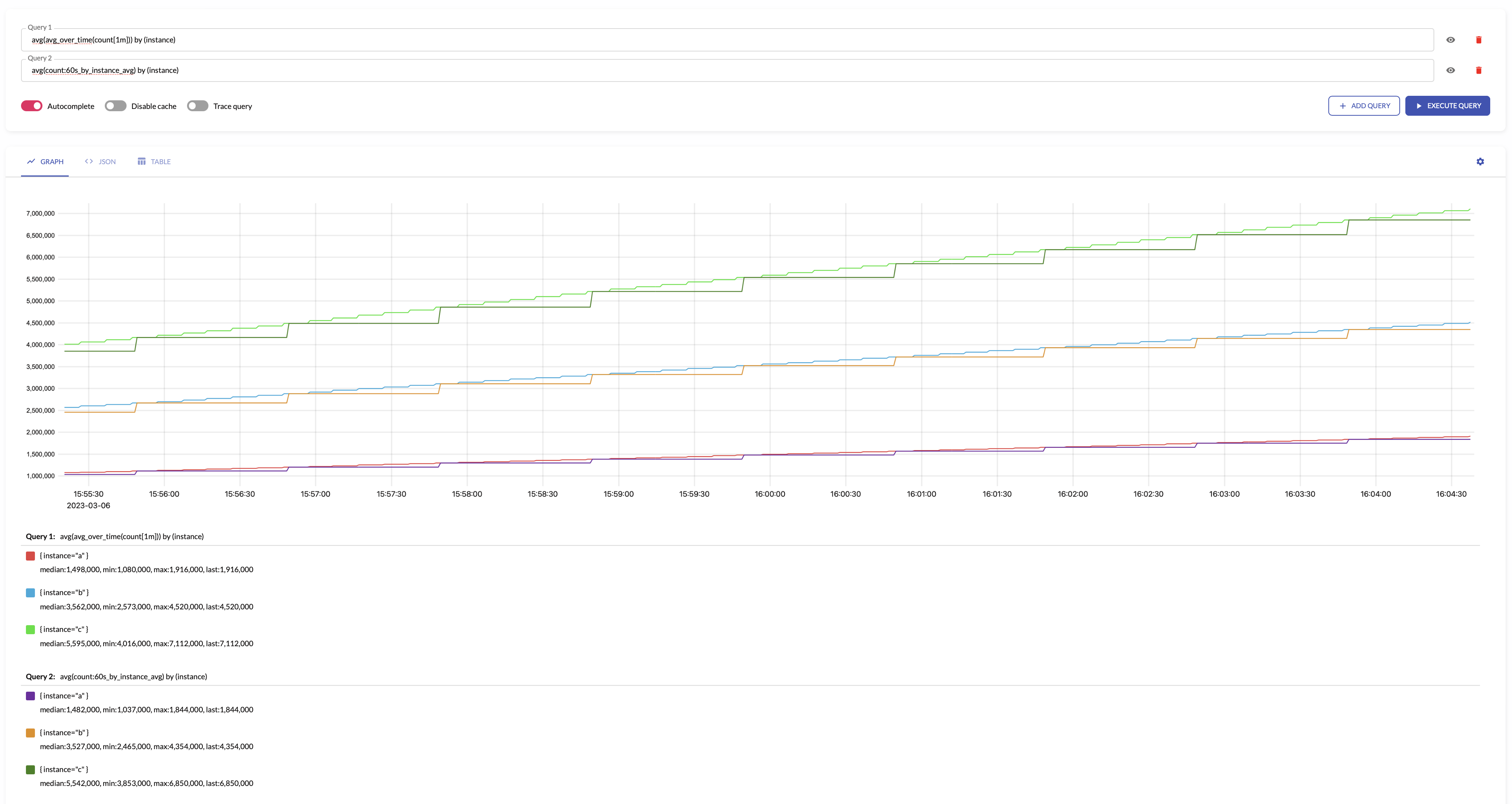
stddev
stddev returns standard deviation for the input sample values.
The results of stddev with aggregation interval of 1m is equal to the stddev_over_time(some_metric[1m]) query.
stdvar
stdvar returns standard variance for the input sample values.
The results of stdvar with aggregation interval of 1m is equal to the stdvar_over_time(some_metric[1m]) query.
For example, see below time series produced by config with aggregation interval 1m and the regular query:
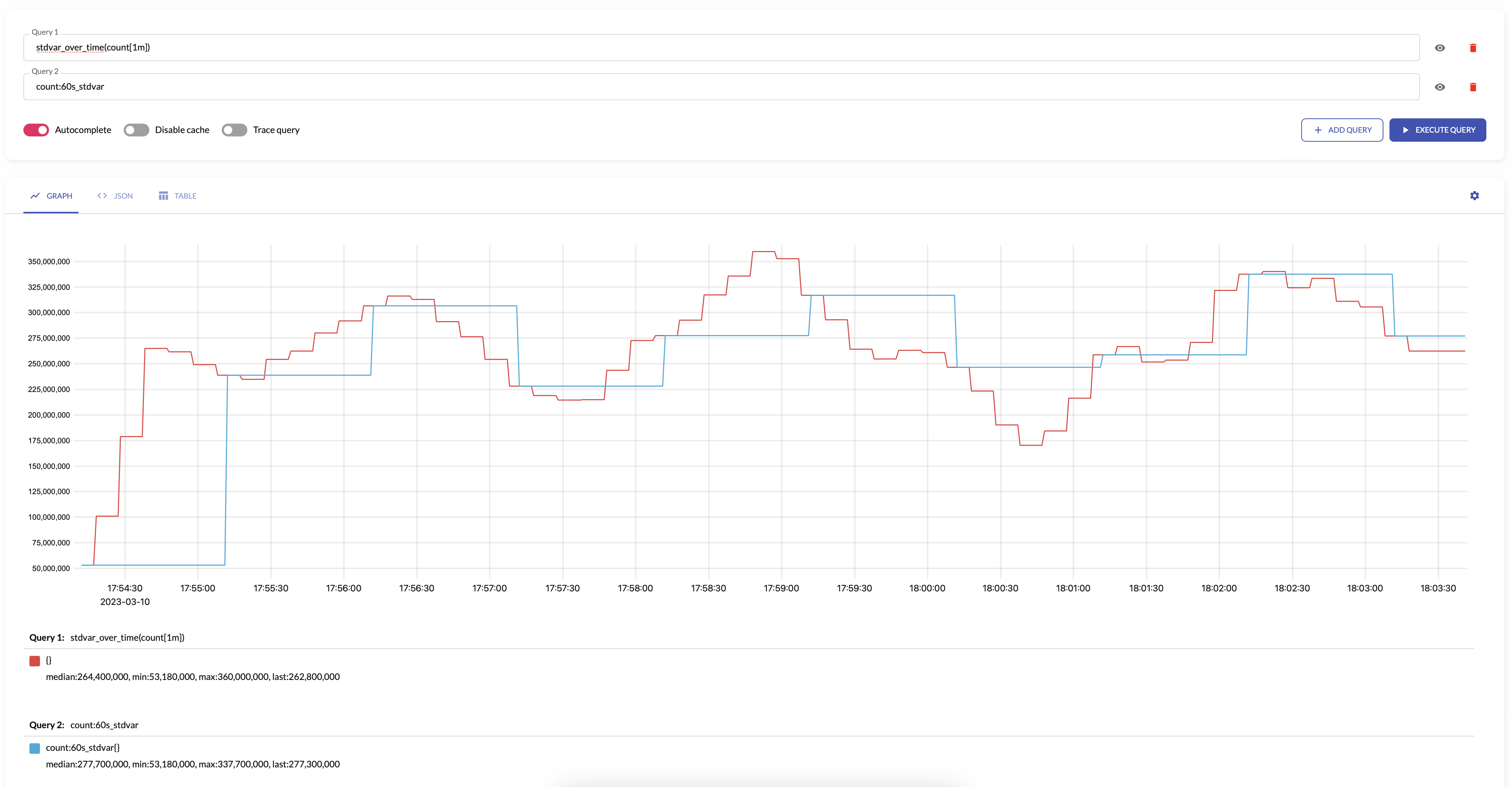
histogram_bucket
histogram_bucket returns VictoriaMetrics histogram buckets
for the input sample values.
The results of histogram_bucket with aggregation interval of 1m is equal to the histogram_over_time(some_histogram_bucket[1m]) query.
quantiles
quantiles(phi1, ..., phiN) returns percentiles for the given phi*
over the input sample values.
The phi must be in the range [0..1], where 0 means 0th percentile, while 1 means 100th percentile.
The results of quantiles(phi1, ..., phiN) with aggregation interval of 1m
is equal to the quantiles_over_time("quantile", phi1, ..., phiN, some_histogram_bucket[1m]) query.
Aggregating by labels
All the labels for the input metrics are preserved by default in the output metrics. For example,
the input metric foo{app="bar",instance="host1"} results to the output metric foo:1m_sum_samples{app="bar",instance="host1"}
when the following stream aggregation config is used:
- interval: 1m
outputs: [sum_samples]
The input labels can be removed via without list specified in the config. For example, the following config
removes the instance label from output metrics by summing input samples across all the instances:
- interval: 1m
without: [instance]
outputs: [sum_samples]
In this case the foo{app="bar",instance="..."} input metrics are transformed into foo:1m_without_instance_sum_samples{app="bar"}
output metric according to output metric naming.
It is possible specifying the exact list of labels in the output metrics via by list.
For example, the following config sums input samples by the app label:
- interval: 1m
by: [app]
outputs: [sum_samples]
In this case the foo{app="bar",instance="..."} input metrics are transformed into foo:1m_by_app_sum_samples{app="bar"}
output metric according to output metric naming.
The labels used in by and without lists can be modified via input_relabel_configs section - see these docs.
See also aggregation outputs.
Stream aggregation config
Below is the format for stream aggregation config file, which may be referred via -remoteWrite.streamAggr.config command-line flag
at vmagent or via -streamAggr.config command-line flag
at single-node VictoriaMetrics:
# match is an optional filter for incoming samples to aggregate.
# It can contain arbitrary Prometheus series selector
# according to https://docs.victoriametrics.com/keyConcepts.html#filtering .
# If match isn't set, then all the incoming samples are aggregated.
- match: 'http_request_duration_seconds_bucket{env=~"prod|staging"}'
# interval is the interval for the aggregation.
# The aggregated stats is sent to remote storage once per interval.
interval: 1m
# without is an optional list of labels, which must be removed from the output aggregation.
# See https://docs.victoriametrics.com/stream-aggregation.html#aggregating-by-labels
without: [instance]
# by is an optioanl list of labels, which must be preserved in the output aggregation.
# See https://docs.victoriametrics.com/stream-aggregation.html#aggregating-by-labels
# by: [job, vmrange]
# outputs is the list of aggregations to perform on the input data.
# See https://docs.victoriametrics.com/stream-aggregation.html#aggregation-outputs
outputs: [total]
# input_relabel_configs is an optional relabeling rules,
# which are applied to the incoming samples after they pass the match filter
# and before being aggregated.
# See https://docs.victoriametrics.com/stream-aggregation.html#relabeling
input_relabel_configs:
- target_label: vmaggr
replacement: before
# output_relabel_configs is an optional relabeling rules,
# which are applied to the aggregated output metrics.
output_relabel_configs:
- target_label: vmaggr
replacement: after
The file can contain multiple aggregation configs. The aggregation is performed independently per each specified config entry.
Configuration update
vmagent and single-node VictoriaMetrics
support the following approaches for hot reloading stream aggregation configs from -remoteWrite.streamAggr.config and -streamAggr.config:
-
By sending
SIGHUPsignal tovmagentorvictoria-metricsprocess:kill -SIGHUP `pidof vmagent` -
By sending HTTP request to
/-/reloadendpoint (e.g.http://vmagent:8429/-/reloador `http://victoria-metrics:8428/-/reload).